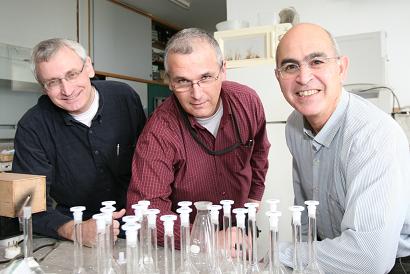This is the first study of its kind in Israel in the field of terrorist threats to the water system, and it was born as a result of the murderous attack on the Twin Towers in New York and the use of anthrax bacteria for biological terrorism

"Following the discovery of documents and plans of the al-Qaeda organization in Afghanistan, the FBI warned that the organization was planning a terrorist attack on water sources," says Professor Israel Shechter of the Technion Faculty of Chemistry. "It turned out that the water distribution systems in the USA, Israel and other developed countries in the world - are completely exposed. They are standing outside without guarding, since these are many large systems that cannot have guards placed on all of them. A committee of experts diligently studied the problem and presented its recommendations to the US Congress. As a result, Congress allocated 608 million dollars to solve the problem."
Professor Schechter began to look into the issue and it became clear to him that a chemical terrorist attack on the water supply system is very difficult to carry out, due to the large risk factor. "It takes a huge amount of poison to poison water supply systems," he explains. "I tried to think like a terrorist, and then I discovered a way in which a handful of a certain type of poison injected into the water sources can indeed cause the death of many people, and this despite the panic factor. That's why I started developing a device that could detect chemical poisoning of water, and neutralize it."
In light of the importance of the issue, the Water Commission also decided to participate in financing the development, together with NATO, the Grand Institute for Water Research and the Institute for Future Defense Research at the Technion.
Professor Yehezkel Kashi from the Faculty of Biotechnology and Food Engineering deals with the rapid identification of pathogenic bacteria in water, such as cholera bacteria. The identification is based on DNA sequences. He and his group at the Technion were able to identify DNA sequences that show great variation between bacterial strains, and developed a technology based on these sequences for the precise identification of the bacteria. "It's basically the ability to determine the ID of certain bacteria," he explains. "Now we are developing the scanner that will be able to identify bacteria in a specific, fast and sensitive way. The development was done in collaboration with Professor David Walt from Taft University in the USA".
The question of where to place the scanner developed by Professor Kashi and the detection and neutralization facility developed by Professor Schechter is solved by Dr. Avi Ostfeld from the Faculty of Civil and Environmental Engineering, who initiated the project and manages it at the Technion. He built a mathematical model that simulates water flows in the network, pressures and pollutant movement, on about one hundred thousand water lines in Tel Aviv, in collaboration with the engineer David Jackman, director of the Water and Sewer Department of the Tel Aviv Municipality. Professor Kevin Lancey from the University of Arizona also participates in the development of the model. According to the model, it will be decided where to place the monitoring stations in the water supply system.
"Water supply systems are built over tens and even hundreds of kilometers," says Dr. Ostfeld. "They consist of water lines, ponds, pumping units and connection points. Physical protection of them is impossible and therefore they are more vulnerable to the deliberate introduction of pollutants."
The project, which was allocated about 300 thousand euros, should be completed at the end of 2008.

One response
Really Cool
All the best to these professors and NLTU
They advance a cure for the blow...!!!
Good luck